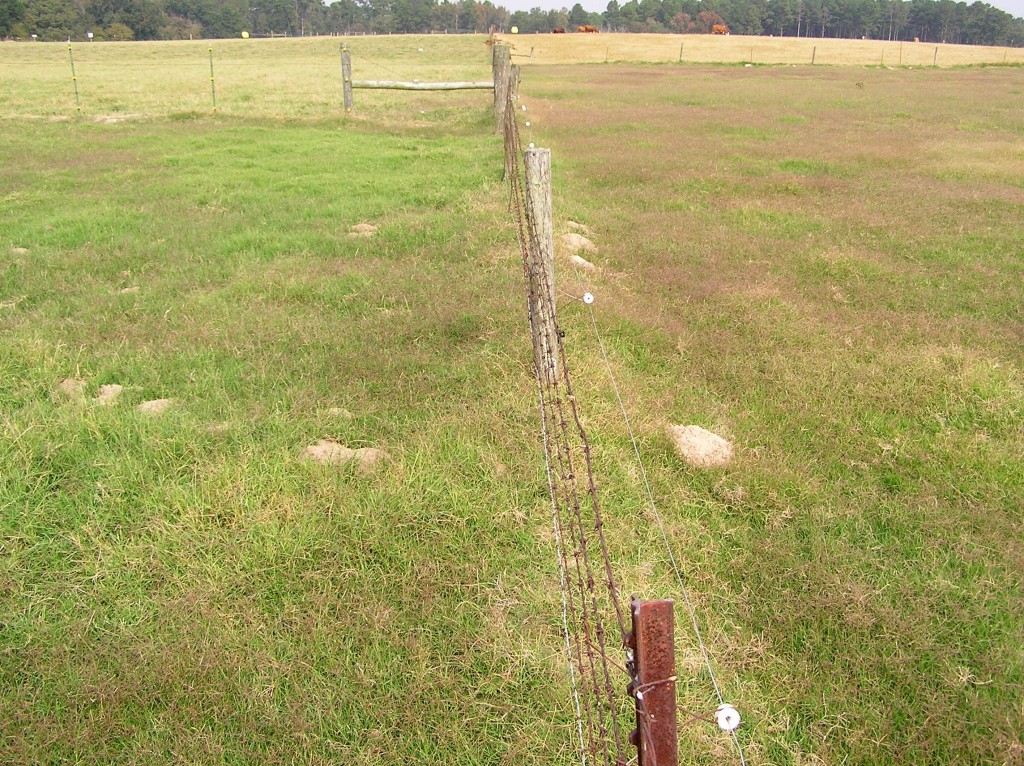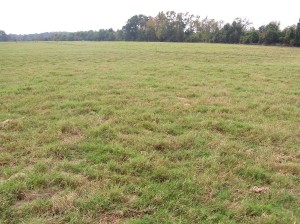Overton, Texas, USA
March 27, 2015

The purple-colored patches on the right side of the fence are signs of invas ion of c ommon Bermuda grass into Coastal Bermuda grass pasture under a high stocking rate, according to a Texas A&M AgriLife Research forage scientist. On the left side of the fence, the stocking rate was medium and shows much less invasion of common ecotypes. The pastures on both side of the fence received nitrogen fertilizer at usual rates during a 30-year study of the effects of stocking rates and nitrogen rates on pastures. (Texas A&M AgriLife Research photo by Dr. Monte Rouquette)
In an East Texas study on sandy, low-fertility soils, Bermuda grass pastures that have not received nitrogen fertilizer since the fall of 1984 are still in production, according to Dr. Monte Rouquette, Texas A&M AgriLife Research forage physiologist, Overton.
The study, which originally began in 1968 on pasture-research areas at the Texas A&M AgriLife Research and Extension Center at Overton, has been conducted by Rouquette since 1971.
The original purpose of the study was to evaluate various forage varieties for production and persistence using cow/calf pairs with different stocking rates, he said.
“The original perception was that this might be a five-year study,” Rouquette said. “But after five years, reality set in, and I realized it was necessary to extend the time period.”
By 1984, rising fossil fuel costs, and along with them, much higher nitrogen fertilizer costs, became a game-changer for beef producers. Rouquette responded by redirecting the grazing study to evaluate the persistence of both common and Coastal Bermuda grass under two different fertility-management strategies: over-seeding with ryegrass and using commercial nitrogen fertilizer; and over-seeding with clover without applying nitrogen.
“I thought that this would be a good time to initiate a nutrient cycling experiment wherein pastures could be treated with nitrogen fertilization and over-seeded with ryegrass versus no nitrogen and over-seeded with clovers for nitrogen fixation,” he said.
Rouquette noted that in 1984, all the test pastures had adequate levels of potassium and phosphorus. As the study proceeded, all test pastures received potassium and phosphorus fertilizer yearly in the form of 0-60-60. Lime was applied as needed.
Bermuda grass is an essential crop to East Texas and the South. Modern varieties of warm-season grass species are well adapted to the climate and soils, and are highly productive, he said.
However, all improved Bermuda grass varieties had one Achilles’ heel: to support their higher production, it was thought they had to have substantial amounts of nitrogen fertilizer applied yearly, he said. This was not a problem as long as nitrogen fertilizer remained a cheap commodity.
“By the early 1970s, nitrogen prices per pound increased two to three times the cost in the 1950s and 1960s,” Rouquette wrote in a 2010 article of The Professional Animal Scientist, which was co-authored by Dr. Gerald “Ray” Smith, AgriLife Research forage breeder, Overton. “The 1970s price increases in N were accompanied by declining cattle prices. These increases … heightened the awareness and need for alternative management strategies and for increased research on forage legumes and management systems for grass-legume pastures in the United States.”
From 2002 through 2008, the price of nitrogen fertilizer increased drastically again, he noted.
Once the experiment was set in motion, there were very few immediate plant responses, Rouquette said. However, by documenting soil status, forage stands and animal performance in the ecosystem over time, Rouquette found:
– Bermuda grass stand composition and longevity are impacted more by stocking rate than lack of commercial nitrogen fertilizer.
– Phosphorous fertilizer levels can be largely replenished by animal excreta.
– Despite what is commonly thought, improved Bermuda grass stands can be maintained indefinitely under grazing at low stocking rates without adding commercial nitrogen fertilizer, but instead relying on nutrient recycling from animal excreta.

This Coastal Bermuda grass received no nitrogen fertilizer in a 30-year study of the effects of stocking rates and nitrogen rates on pastures. Be cause st ocking rates were kept low, about one cow/calf unit per acre for East Texas, the stand showed essentially little to no invasion of less-productive, common Bermuda grass ecotypes, according to Dr. Monte Rouquette, the Texas A&M AgriLife Research forage scientist conducting the study. (Texas A&M AgriLife Research photo by Dr. Monte Rouquette)
When the study began in 1969 and until 1984, common and Coastal Bermuda grass pastures received about 200 pounds of nitrogen fertilizer, and 100 pounds each of phosphorus and potassium fertilizers per acre, per year. The nitrogen was split, applied over the growing season while the potassium and phosphorus were applied in the fall in a single application.
Until 1974, both types of Bermuda grass were evaluated for production and quality as pure stands under different stocking rates. The average stocking rates were 1, 1.7 and 3 cow/calf pairs per acre on Coastal Bermuda grass. On the common Bermuda grass paddocks, the average stocking rates were 0.8, 1.4 and cow/calf pairs per acre.
From 1974 to 1983, Rouquette kept the same fertilization rates, but paddocks of both Bermuda grass types were overseeded with mixtures of clover and Gulf annual ryegrass in October.
In subsequent years, the type of clover was varied among Yuchi, Arrowleaf, Tibee crimson and subterranean clover. Grazing of Bermuda grass was halted in early October to allow the cool-season over-seeded clovers to become established.
“From 1985 to 2015, as energy costs began to rise, we wanted to evaluate forage sustainability, productivity and soil nutrient levels in the Bermuda grass pastures with and without commercial nitrogen applications,” Rouquette said.
“When you look solely at Coastal Bermuda grass forage production, then added nitrogen and ryegrass is the clear winner,” Rouquette said. “But when you’re looking for sustainability, then reduced input, mainly no-nitrogen plus clover is the way to go.”
These results run counter to the common perception of Bermuda grass pasture management, Rouquette said. It’s commonly thought that without nitrogen fertilization, an improved Bermuda grass stand will be taken over by such low quality grasses as Bahiagrass.
“But that’s true only if the stand is over-grazed as well,” he said. “Under our ‘low’ stocking rates, which was about one cow/calf pair per acre, this didn’t happen.”
One cow/calf pair per acre is actually a considerably higher stocking rate than used by many commercial livestock producers, he noted.
Instead, with no nitrogen fertilizer, the originally planted Bermuda grass stands were reduced over time by the invasion of other ecotypes of Bermuda grass, Rouquette said.
“The invading ecotypes were more similar to common Bermuda grass,” he said. “They were still productive — they just were just not as productive as Coastal.”
This lower productivity was largely offset by lower production inputs with high nitrogen fertilizer costs, he noted.
Rouquette said the important points to take home are:
- At high stocking rates, without nitrogen, there was a major invasion of other ecotypes and Bahiagrass.
- At low stocking rates, about 75 percent of the original Coastal Bermuda grass stand remained, even without nitrogen fertilizer applications, though the over-seeded legumes did supply some nitrogen.
“It’s commonly thought that without nitrogen fertilizer, Bermuda grass fields will turn to sand and brush,” he said. “But that’s only true if animal grazing is ceased too. With animal grazing, nutrient recycling of animal excreta will maintain the stand – possibly forever.”
The nutrient cycling pasture experiment is one of — if not the only one — of its kind with introduced forages in the U.S., according to Rouquette.